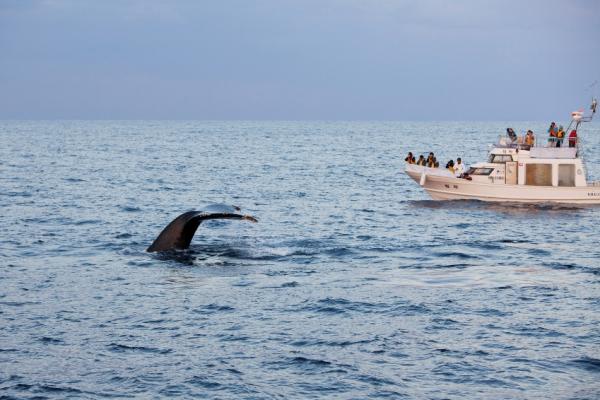Animal Viewing - Cetacean Viewing

Tourism aimed at cetacean viewing is continuously growing. If properly managed, this kind of activity is an extraordinary tool for environmental education, the improvement of local populations, and a crucial boost in the promotion and scientific research of marine mammals.
Due to the growing interest in this activity, there are numerous associations that have signed agreements to develop guides and codes of good practice. Since 2004, ACCOBAMS (Agreement on the Conservation of Cetaceans of the Black Sea, Mediterranean Sea and contiguous Atlantic Area) has been developing a collaboration agreement with different operators to obtain a certificate of responsible sighting.
This type of tourism requires extreme precaution measures. A bad practice in cetacean viewing can cause collisions that endanger the life of the animal and the people on board the boat. Animals can alter their behavior if they are disturbed by our activities. If the cetaceans are concerned or do not show interest in being close to the boat, behavior changes can be observed. We must always give animals time and space.
If you are planning to carry out cetacean viewing on your holidays, previously make sure of the code of conduct of the operator you are contracting. Here you can find the current regulations in Spain regarding the protection of cetaceans in application of the Habitats Directive for the conservation of Natural Habitats and of Wild Fauna and Flora. [1]
The sighting of cetaceans must always respect the following points:
- Always respect the minimum safety distance (100m). The approach should be slow and quiet. Ideally, approach the animals from parallel and slightly to the rear.
- Do not stay with the animals too long (suggested maximum time of half hour). If changes in behaviour or signs of discomfort are observed, retreat slowly and quietly.
- Do not surround or navigate around a group. We are in danger of separating or dispersing it, something especially dangerous when there are mothers and cubs. Do not enter a group of dolphins to encourage them to bow-ride.
- Sometimes animals could get close to the boat. In these cases the engines should be put in neutral position and not propel the boat until they are far from the boat. If the animal approaches the boat to swim in front of its bow, maintain a constant course and speed.
- Helicopters or any aircraft should cease contact if the animals repeatedly dive or increase speed.
- The presence of a person in charge is always required to control the location of all animals at any moment, assisting the vessel operator.
- Stay away from whales when they are feeding.
- The presence of more than one boat at a time is not recommended. In case it happens, no more than 2 boats or 4 small boats. Communication and coordination between them must be constant.
- Ensure coordination of approaches to avoid cornering cetaceans, creating a "tunnel" for boats or crossing their travel routes.
- Be aware of local geography – never ‘trap’ animals between the vessel and shore.
- Avoid sudden or repeated changes in direction, speed or changing gears when close to marine mammals.
- If a boat is closer than the recommended minimum distance, it should be removed at a slow, steady speed and not cause waves, until reaching at least 100m of distance. Be aware that whales may surface in unexpected locations.
- Many of these mammals, especially whales, show tail or fin movements when they are socializing with each other and may not be aware of boats. Keep your distance.
- Humpback whales, for example, emit sub-surface bubbles before rising to feed at the surface. Avoid these spaces.
- Emitting periodic noise can help whales know your position and avoid whale and boat collisions.
- Be quiet and restrict passenger movement in small boats during close encounters.
Responsible Cetacean viewing companies in Spain
[1] Los anexos II y IV de la Directiva 92/43/CEE del Consejo, de 21 de mayo incluyen al delfín mular (Tursiops truncatus) y a la marsopacomún (Phocoena phocoena) como animales de interés comunitario para cuya conservación es necesario designar Zonas Especiales de Conservación, y al resto de los cetáceos como animales de interés comunitario que requieren protección estricta.
